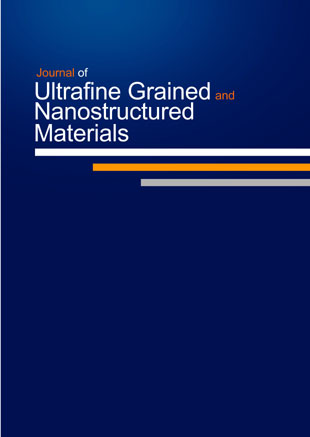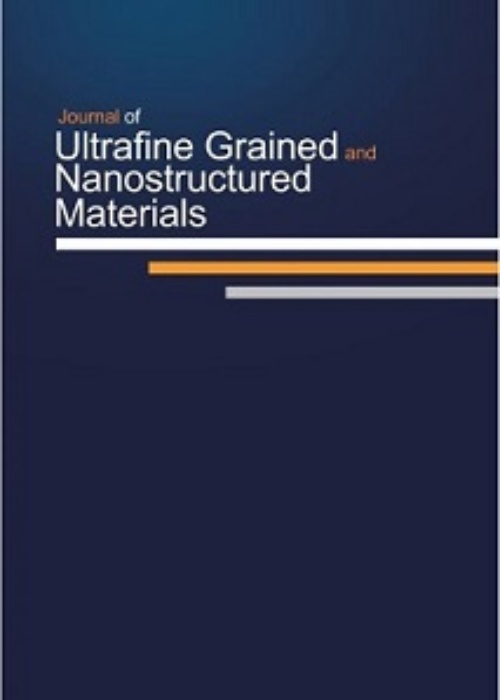فهرست مطالب

Journal of Ultrafine Grained and Nanostructured Materials
Volume:46 Issue: 1, Jun 2013
- تاریخ انتشار: 1392/05/14
- تعداد عناوین: 10
-
-
Pages 1-9Carbon nanotubes (CNTs) are specific structures with valuable characteristics. In general, the structure of each nanotube is defined by a unique chiral vector. In this paper, different structures of short single-walled CNTs are simulated and their mechanical properties are determined using finite element method. For this aim, a simple algorithm is presented which is able to model the geometry of single-walled CNTs with any desired structure based on nano-scale continuum mechanics approach. By changing the chiral angle from 0 to 30 degree for constant length to radius ratio, the effect of nanotube chirality on its mechanical properties is evaluated. It is observed that the tensile modulus of CNTs changes between 0.93-1.02 TPa for different structures, and it can be higher for chiral structures than zigzag and armchair ones. Also, for different chiral angles, the bending modulus changes between 0.76-0.82 TPa, while the torsional modulus varies in the range of 0.283-0.301TPa.Keywords: Carbon Nanotube, Chirality, Tensile Rigidity, Bending Rigidity, Torsional Rigidity
-
Pages 11-17In this research, mesoporous silica was applied as the host of corrosion inhibitor (molybdate). The loaded mesoporous silica was dispersed in an epoxy matrix. The composite was then coated on the mild steel plate. Results showed that the corrosion resistance of the scratched epoxy/mesoporous silica loaded by molybdate was better than the one without molybdate or neat epoxy. On the other hand, EDX and FTIR studies showed the release of corrosion inhibitor in the scratched zone. It was due to pH-sensitive release of corrosion inhibitor in the aggressive media. Also, XRD data showed the presence of Mo compounds on the surface of steel.Keywords: Corrosion Inhibitor, Mesoporous silica, Polymeric coatings, FTIR, XRD
-
Pages 19-24ZnO nanowires with a diameter of 70 nm and nanorods with a diameter in the range of 100-150 nm and two micrometer in length were grown on glass substrates by resistive evaporation method and applying a two step oxidation process at low temperatures, without using any catalyst, template or buffer layer. XRD pattern of these nanostructures indicated a good crystallinity property with wurtzite hexagonal structure. Photoluminescence measurement revealed three band emissions; one sharp strong peak in the UV region and two weaker peaks in the visible region, indicate good optical properties of nanorods synthesized by this method. Heat treatment in oxygen-rich atmosphere results to decrease of deep-level emission intensity in the PL spectra. The relatively high intensity of UV emission implies that this approach is a simple and promising method for fabricating ZnO nanorods in order to be used in optoelectronic devices especially in the UV range of the spectrum.Keywords: ZnO Nanowires, Nanorod, Resistive Evaporation, Oxidation, Photoluminescence
-
Pages 25-29The study of nucleation mechanism of new grains during severe plastic deformation of magnesium alloys is of great importance to control the characteristics of final microstructures. To investigate the role of discontinuous recrystallization, a wrought AZ31 magnesium alloy was deformed by accumulative back extrusion process at 330 °C. The obtained microstructures were studied using optical and field emission microscopy as well as electron back scattered diffraction techniques. The results demonstrated that the fine and ultrafine grains formed along the prior grain boundaries yielding a bimodal structure. The EBSD analysis showed that the new grains exhibit a similar basal texture to deformed grains, which may confirm the operation of strain induced boundary migration mechanism.Keywords: Microstructure, DRX, ABE, EBSD
-
Pages 31-37high purity fluorapatite (FA) with rod-like and spherical-like morphology was synthesized via sol-gel method. Chemical characterization of FA powders was done by XRD and FTIR analyses. Crystallite samples were calculated using Scherer method. Morphology of FA powders was investigated with TEM and SEM images. The results revealed that increasing the time of hydrolysis of phosphate sols significantly decreased the gelation time of FA sols. Also, mixing temperature of P and Ca sols affects the gelation time of samples and increasing pH decreases the gelation time of FA sols. Morphological and chemical characterization of samples showed that the FA powders have high purity and rod-like and spherical-like morphology.Keywords: Fluorapatite, Sol, Gel, Rod, like, High, purity, Nanopowders
-
Pages 39-45The nanostructured anatase TiO2 with high thermal stability was prepared by polymeric sol-gel method without any additives. The particle size distribution of polymeric titania sol was determined by dynamic light scattering (DLS). Then properties of obtained titania were investigated by TG-DTA, XRD, FESEM and TEM. Also, the decolorization capability of resultant anatase was evaluated using methyl orange degradation in aqueous solution by UV–visible spectrophotometer. The results of DLS showed that the particle size distribution of the polymeric sol, after 1 and 50 days is in the range of 0.5-2 and 1-3 nm, respectively. The polymeric gel calcined at different temperatures resulted crystalline structure of anatase that showed high thermal stability against phase transformation up to 750 °C. Also, crystallite size of anatase calcined at 400-750 °C was in the range of 10-50 nm. The prepared nanostructured anatase in this research showed a significant decolorization capability for methyl orange degradation.Keywords: Nanostructure, Anatase, Sol, Gel, Thermal Stability, Decolorization
-
Pages 47-54This study investigated the influence of nanoclay on the impact damage resistance of glass fiber-epoxy composites under high velocity ice impact loading. Addition of 0.5 wt. % nanoclay into epoxy was shown to improve damage resistance compared to composite plates having no nanoclay platelet. The glass fiber-epoxy composites containing nanoclay brought about substantial improvement in ice impact damage resistance and damage tolerance in the form of smaller damage area. Delamination followed by high velocity ice impact constituted major damage mode in the specimens tested.Keywords: Nanoclay, High Velocity Ice Impact, Damage Extension
-
Pages 55-59The nanocrystallization of Co67Fe4Cr7Si8B14 amorphous ribbons which prepared by planar flow melt spinning process (PFMS) was investigated. Crystallization of the ribbons was studied by differential thermal analysis (DTA), X-ray diffraction (XRD) and transmission electron microscopy (TEM). The DTA result of amorphous ribbon at heating rate of 10˚C/min showedoccurrence of phase transitions in two stages. The ribbons were isothermally annealed for 30 minutes in argon atmosphere at different temperatures between 300 and 650ºC with 25ºC steps. The magnetic properties of annealed samples were measured using a vibrating sample magnetometer (VSM). The VSM results revealed that optimum soft magnetic properties occurred at 400ºC. XRD patterns showed that the samples isothermally annealed up to 450ºC were amorphous, while TEM results at 400ºC indicated 7-8 nm mean size nanocrytallites in amorphous matrix and size of the nanocrystallites increased by increasing temperature. Also by X-ray diffraction pattern, precipitation of different phases at higher temperatures confirmed.Keywords: Amorphous Alloy, Transmission Electron Microscopy, Nanocrystallization, Soft Magnetic Properties, XRD
-
Pages 61-66In this research, a novel method to decrease micro-residual stresses of fibrous composites by adding carbon nanotubes (CNTs) is proposed in detail. The negative coefficient of thermal expansion and the high young’s modulus of CNTs can be utilized to counterbalance the process induced residual stresses in composites. To this end, first, the effects of adding CNTs to the matrix of fibrous composites in reducing the coefficient of thermal expansion (CTE) and increasing of young’s modulus of matrix are studied theoretically. Then, a three phase micromechanical model (the energy method) is used to model the effect of CNT in reducing the residual stresses of fibrous composites. The results show that by addition of CNTs, enhancements in properties of matrix are obtained and lead to decrease in micro-residual stresses of matrix and fiber up to 72%.Keywords: Residual Stress, Carbon Nanotube, Fibrous Composite, Polymer
-
Pages 67-74The pellet-type SnO2 sensor was synthesized by the solid state method and the effects of additives such as nano ZnO (1-12 mol %) and nano In2O3 (1-10 mol %) on the CO gas sensitivity of sensor were investigated. The optimum sintering temperature was chosen 800°C because of the porosity content of the samples. The phase analysis and microstructure of the samples were studied by x-ray diffraction and scanning electron microscopy, respectively. Results show that the electrical resistivity variations of the samples with time increased by increasing the amount of additives up to the optimum value for each additive. These optimum values were 10 and 7.5mol% for nano ZnO and nano In2O3, respectively. The best sensitivity and recovery and response times were obtained in the co-doped sample containing 10 mol% nano ZnO and 7.5 mol% nano In2O3. The higher values of the additives decreased the sensitivity of the samples due to the formation of undesirable phases.Keywords: SnO2 Sensor, ZnO, In2O3, CO Gas, Resistivity


